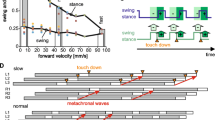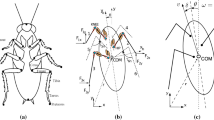Abstract
Leg movements of stick insects (Carausius morosus) making turns towards visual targets are examined in detail, and a dynamic model of this behaviour is proposed. Initial results suggest that front legs shape most of the body trajectory, while the middle and hind legs just follow external forces (Rosano H, Webb B, in The control of turning in real and simulated stick insects, vol. 4095, pp 145–156, 2006). However, some limitations of this explanation and dissimilarities in the turning behaviour of the insect and the model were found. A second set of behavioural experiments was made by blocking front tarsi to further investigate the active role of the other legs for the control of turning. The results indicate that it is necessary to have different roles for each pair of legs to replicate insect behaviour. We demonstrate that the rear legs actively rotate the body while the middle legs move sideways tangentially to the hind inner leg. Furthermore, we show that on average the middle inner and hind outer leg contribute to turning while the middle outer leg and hind inner leg oppose body rotation. These behavioural results are incorporated into a 3D dynamic robot simulation. We show that the simulation can now replicate more precisely the turns made by the stick insect.
Similar content being viewed by others
References
Bässler U, Foth E, Breutel G (1985) The inherent walking direction differs for the prothoracic and metathoracic legs of stick insects. J Exp Biol 116:301–311
Bläsing B, Cruse H (2004) Stick insect locomotion in a complex environment: Climbing over large gaps. J Exp Biol 207:1273–1286
Cruse H (1976) The control of body position in the stick insect (Carausius morosus), when walking over uneven surfaces. J Biol Cybern 24:25–33
Cruse H, Bartling C (1995) Movement of joint angles in the legs of a walking insect, Carausius morosus. J Insect Physiol 41(9):761–771
Cruse H, Schmitz J, Braun U, Schweins A (1993) Control of body height in a stick insect walking on a treadwheel. J Exp Biol 181:141– 155
Cruse H, Bartling C, Cymbalyuk G, Dean J, Dreifert M (1995) Modular artificial neural net for controlling a six-legged walking system. Biol Cybern 72:421–430
Cruse H, Bartling C, Dean J, Kindermann T, Schmitz J, Schumm M, Wagner H (1996) Coordination in a six–legged walking system. simple solutions to complex problems by exploitation of physical properties. In: Maes P, Mataric MJ, Meyer JA, Pollack J, Wilson SW (eds), From animals to animats 4. MIT Press, Cambridge pp 84–93
Cruse H, Kindermann T, Schumm M, Dean J, Schmitz J (1998) Walknet-a biologically inspired network to control six-legged walking. Neural Netw 11:1435–1447
Domenici P, Jamon M, Clarac F (1998) Curve walking in freely moving crayfish. J Exp Biol 201:1315–1329
Dürr V (2001) Stereotypic leg searching movements in the stick insect: kinematic analysis, behavioural context and simulation. J Exp Biol 204:1589–1604
Dürr V (2005) Context-dependent changes in strength and efficacy of leg coordination mechanisms. J Exp Biol 208:2253–2267
Dürr V, Ebeling W (2005) The behavioural transition from straight to curve walking: kinetics of leg movement parameters and the initiation of turning. J Exp Biol 208:2237–2252
Dürr V, Matheson T (2003) Graded limb targeting in an insect is caused by the shift of a single movement pattern. J Neurophysiol 90:1754–1765
Ekeberg Ö, Blümel M, Büschges A (2004) Dynamic simulation of insect walking. Arthropod Struct Develop 33:287–300
Full RJ, Stokes DR, Ahn AN, Josephson RK (1998) Energy absortion during running by leg muscles in a cockroach. J Exp Biol 201:997–1012
Jander R, Volk-Heinrichs I (1970) Das strauch-spezifische visuelle perceptor-system der Stabheuschrecke (Carausius Morosus). Z Vgl Physiol 70:425–447
Jindrich DL, Full RJ (1999) Many-legged maneuverability: dynamics of turning in hexapods. J Exp Biol 202:1603–1623
Kindermann T (2001) Behavior and adaptability of a six-legged walking system with highly distributed control. Adap Behav 9:16–41
Mu L, Ritzmann RE (2005) Kinematics and motor activity during tethered walking and turning in the cockroach, Blaberus discoidalis. J Comp Physiol A 191:1037–1054
Rosano H, Webb B (2006) The control of turning in real and simulated stick insects. In: Nolfi S, Baldassarre G, Calabretta R, Hallam J, Marocco D, Meyer JA, Parisi D (eds), From animals to animats 9. LNAI, vol 4095, Springer, Berlin, pp 145–156
Schmitz J, Dean J, Kindermann T, Schumm M, Cruse H (2001) A biologically inspired controller for hexapod walking: simple solutions by exploiting physical properties. Biol Bull 200:195–200
Schneider A, Cruse H, Schmitz J (2005) A biologically inspired active compliant joint using local positive velocity feedback (lpvf). IEEE Trans Syst Man Cybern 35:1120–1130
Author information
Authors and Affiliations
Corresponding author
Additional information
This work was supported by CONACYT México and the European Commission under project FP6-2003-IST2-004690 SPARK.
Rights and permissions
About this article
Cite this article
Rosano, H., Webb, B. A dynamic model of thoracic differentiation for the control of turning in the stick insect. Biol Cybern 97, 229–246 (2007). https://doi.org/10.1007/s00422-007-0170-4
Received:
Accepted:
Published:
Issue Date:
DOI: https://doi.org/10.1007/s00422-007-0170-4




